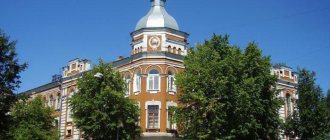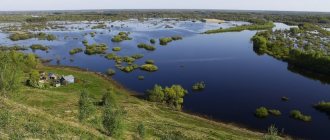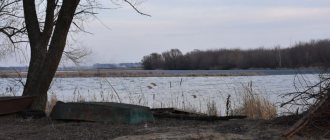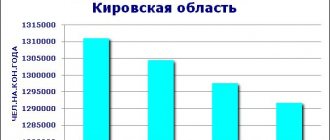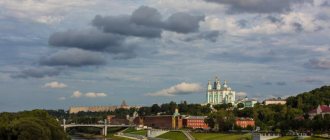Administrative division of the first level of Russia
Central region, Russia
| Tambov Region | |
| Region | |
| Tambov Region | |
| Flag Coat of arms | |
| Anthem: Farewell of the Slavyanka[3] | |
| Coordinates: 52°43′N 41°34'E / 52.717°N Latitude 41.567°E / 52.717; 41.567Coordinates: 52°43′N 41°34'E / 52.717°N Latitude 41.567°E / 52.717; 41.567 | |
| A country | Russia |
| Federal District | Central[1] |
| Economic region | Central Black Earth Region[2] |
| Established | September 27, 1937[4] |
| Administrative center | Tambov[5] |
| Government | |
| • Body | Regional Duma[6] |
| • Governor[8] | Alexander Nikitin[7] |
| Square [9] | |
| • General | 34,300 km2 (13,200 sq mi) |
| Area Rank | 63rd |
| population (2010 Census)[10] | |
| • General | 1,091,994 |
| • Evaluate (2018)[11] | 1,033,552 (−5.4%) |
| • Classify | 48th |
| • Density | 32/km2 (82/sq mi) |
| • Urban | 58.7% |
| • Rustic | 41.3% |
| Timezone | UTC + 3 (MSK [12]) |
| ISO 3166 code | RU-TAM |
| Number plates | 68 |
| OKTMO I WOULD | 68000000 |
| official languages | Russian[13] |
| Web site | https://www.tambov.gov.ru/ |
Tambov Region
(Russian: Tambovskaya oblast,
Tambovskaya oblast
) is a federal subject of Russia (an oblast). Its administrative center is the city of Tambov. As of the 2010 Census, its population was 1,091,994.[10]
Story
The oldest known population of the Tambov region is the Mordovians-Moksha, formed as a nation from local ethnic groups from the 6th century BC. The first Russian settlers arrived in the pre-Mongol period, but final settlement occurred in the 17th century. To protect the southern borders of Russia from Tatar raids and further development of the Black Earth Region, the Russian government built the walled cities of Kozlov (1635) and Tambov (1636). The cities guarded the main route of nomadic raids on Russian lands and prepared the way for the rapid settlement of the region.
Kozlovsky district originally existed in the Tambov region. During the administrative reforms of Peter the Great in 1708 and 1719, it became part of the Azov province. New administrative divisions created the Tambov governorship in 1779 and since 1796 the Tambov province, with an area of 66.5 thousand km2, is divided into 12 counties. The boundaries of the province remained almost unchanged, and the governorship existed until 1928.
An attempt to establish Soviet control over the Tambov region led to the defeat and execution of “Red Sonja” (Sofia Nukhimovna Gelberg) in the spring of 1918.[14]
During the Russian Civil War, the anti-Bolshevik uprising, the Tambov Uprising, broke out in the Tambov province in 1920–1921.
The Tambov region was finally formed from the Voronezh and Samara regions on September 27, 1937. The region acquired its current form after the separation of the Penza region (previously part of Kuibyshev before joining Tambov) on February 4, 1939.
Tambov Region. Districts
In September 1937, parts of the territory were separated from the Voronezh and Kuibyshev regions, which later formed the Tambov region. The region includes more than 300 municipalities. Currently, the total area of the region is more than 34.5 km2, and the population has exceeded 1 million people.
The main emphasis in industrial development is on mechanical engineering (spare parts and components for tractors and cars, equipment for textile and chemical production). Sugar production brings significant income to the region's treasury. The agricultural sector produces almost 20% of the entire regional gross product. The priority in the development of this sector is due to the fact that 42% of the region’s population lives in black soil areas. Two state universities located in the regional center allow young people to pursue higher education.
Tambov Region. Map (The dotted line indicates the boundaries of the area on the map)
Transport interchanges mainly belong to railways and highways. Sections of the South-Eastern Railway and Kuibyshev Railway pass through the territory. In the village of Donskoye (not far from Tambov) there is an airport serving local airlines. Sports facilities, including 35 schools, 19 stadiums, courts and playgrounds, allow 235 thousand people to engage in sports, both professionally and at the amateur level.
Districts of the Tambov region and regional centers:
|
|
Urban districts:
|
Administrative-territorial division of the Tambov region Map by district
Cities and towns:
|
|
Demography
Population
: 1,091,994 (2010 Census);[10]1,178,443 (2002 Census);[15]1,320,763 (1989 Census).[16]
2012
- Births: 10,394 (9.6 per 1,000)
- Deaths: 17,386 (16.1 per 1000) [17]
Total fertility rate[18]
- 2009: 1.31
- 2010: 1.34
- 2011: 1.33
- 2012: 1.42
- 2013: 1.42
- 2014: 1.49
- 2015: 1.51
- 2016: 1.49(e)
Ethnic Composition (2010)[10]
- Russians: 97%
- Ukrainians: 0.7%
- Armenians: 0.4%
- Gypsy people: 0.4%
- Other: 1.5%
- 22,708 people were registered in administrative databases and could not indicate their nationality. It is estimated that the proportion of ethnic groups in this group is the same as in the stated group.[19]
Calculations
The largest cities in the Tambov region All-Russian census 2010 | |||||||||
| Classify | Administrative division | Pop. | |||||||
| Tambov Michurinsk | 1 | Tambov | Tambov district | 280,161 | |||||
| 2 | Michurinsk | Michurinsky district | 98,758 | ||||||
| 3 | Rasskazovo | Rasskazovsky district | 45,484 | ||||||
| 4 | Morshansk | Morshansky district | 41,556 | ||||||
| 5 | Kotovsk | Town of regional significance Kotovsk | 31,850 | ||||||
| 6 | Uvarovo | Uvarovsky district | 26,830 | ||||||
| 7 | Builder | Tambov district | 18,437 | ||||||
| 8 | Kirsanov | Kirsanovsky district | 17,224 | ||||||
| 9 | Zherdevka | Zherdevsky district | 15,209 | ||||||
| 10 | Pervomaisky | Pervomaisky district | 12,654 | ||||||
Religion
| Religion in the Tambov region as of 2012 (Atlas Sreda Arena)[20][21] | ||||
| Russian Orthodoxy | 78.4% | |||
| Other Christians | 1% | |||
| Spiritual but not religious | 6.7% | |||
| Atheism and godlessness | 10% | |||
| Other and undeclared | 3.9% | |||
According to a 2012 survey,[20] 78.4% of the population of the Tambov region adheres to the Russian Orthodox Church, making it the federal subject with the highest percentage of this religion in the entire country. In addition, 1% of the unaffiliated overall are Christians, 7% of the population declares to be "spiritual but not religious", 10% are atheist, and 3.6% follow other religions or did not answer the question.[20]
Recommendations
Notes
- President of Russian Federation. Decree No. 849 of May 13, 2000 “On the Plenipotentiary Representative of the President of the Russian Federation in the Federal District.” Entered into force on May 13, 2000. Published: “Collection of Legislation of the Russian Federation”, No. 20, Art. 2112, May 15, 2000 (Decree of the President of the Russian Federation of May 13, 2000 No. 849). On the plenipotentiary representative of the President of the Russian Federation in the federal district
. Effective May 13, 2000). - Gosstandart of the Russian Federation. No. OK 024-95 December 27, 1995 “All-Russian classifier of economic regions. 2. Economic regions,” ed. Changes No. 5 / 2001 OKER. (Gosstandart of the Russian Federation. No. OK 024-95 December 27, 1995. Russian classification of economic regions. 2. Economic regions
, as amended by Amendment No. 5/2001 OKER.). - Law No. 27-Z
- Charter of the Tambov Region, Article 2
- Charter of the Tambov Region, Article 5.
- Charter of the Tambov Region, Article 49.
- "Nikitin Alexander Valerievich." Retrieved August 18, 2022.
- Charter of the Tambov Region, Article 66.
- Federal State Statistics Service (Federal State Statistics Service) (May 21, 2004). Territory, number, settlements and rural administrations by constituent entity of the Russian Federation ( Territory, number of districts, settlements and rural administration by constituent entity of the Russian Federation
)".
All-Russian Population Census of 2002 (All-Russian Population Census of 2002)
(in Russian). Federal State Statistics Service. Retrieved November 1, 2011. - ^ a b c d
Federal State Statistics Service of Russia (2011).
“All-Russian Population Census 2010. Volume 1" [All-Russian Population Census 2010, vol. 1]. All-Russian Population Census 2010 [All-Russian Population Census 2010]
(in Russian). Federal State Statistics Service. - "26. The size of the permanent population of the Russian Federation by municipalities as of January 1, 2022.” Federal State Statistics Service. Retrieved January 23, 2022.
- "On the calculation of time." Official Internet portal of legal information
(in Russian). June 3, 2011. Retrieved January 19, 2022. - An official throughout the Russian Federation in accordance with Article 68.1. Constitution of Russia.
- Sennikov, B. V. (2004). Rumyantsev, Vyacheslav (ed.). Tambov uprising 1918-1921 and the de-peasantization of Russia 1929-1933. [Tambov uprising of 1918-1921 and depeasantization of Russia 1929-1933]. Rumyantsev Museum
. Library of Russian Studies. Moscow: Posev. ISBN 5-85824-152-2. Received February 9, 2014. Gelberg S.N. (“Red Sonja”) (? -1918). Midwife. Commander of the flying detachment of the Red Guard, operating on the territory of the Tambov province in the spring of 1918, whose task was to impose Soviet power. The “Red Sonya” detachment was distinguished by its cruelty; its appearance resulted in numerous robberies of the population. The detachment was defeated by the peasants. “Red Sonya” herself was executed by the verdict of several volosts of the province. - Federal State Statistics Service of Russia (May 21, 2004). “The population of Russia, the constituent entities of the Russian Federation as part of federal districts, urban settlements, urban settlements, settlements, settlements of 3 thousand or more people.” [Population of Russia, its federal districts, constituent entities of the Federation, districts, urban settlements, rural settlements - administrative centers and rural settlements with a population of more than 3000 people] (XLS). All-Russian Population Census of 2002 [All-Russian Population Census of 2002]
(in Russian). - “All-Union Population Census of 1989. The current population of union and autonomous republics, autonomous regions and districts, territories, regions, urban settlements and rural district centers” [All-Union Population Census of 1989: current population of union and autonomous republics, autonomous regions and districts, territories, regions, districts, urban settlements and villages that are district administrative centers]. All-Union Population Census of 1989 [All-Union Population Census of 1989]
(in Russian).
Institute of Demography of the National Research University: Higher School of Economics [Institute of Demography of the National Research University: Higher School of Economics]. 1989 - via Demoscope weekly
. - https://www.gks.ru/free_doc/2012/demo/edn12-12.htm
- https://www.gks.ru/wps/wcm/connect/rosstat_main/rosstat/ru/statistics/publications/catalog/doc_1137674209312
- https://www.perepis-2010.ru/news/detail.php?ID=6936
- ^ a b c
"Arena: Atlas of religions and nationalities of Russia." Wednesday, 2012.
. “Ogonyok”, No. 34 (5243), 08/27/2012. Retrieved 04/21/2017. .
Sources
- Tambov Regional Duma. Law No. 27-Z of May 24, 2002 “On the anthem of the Tambov region,” as amended. Law No. 378-Z of February 10, 2014 “On amendments to certain legislative acts of the Tambov region on the use of official symbols of the Tambov region.” Came into force on the date of official publication (June 15, 2002). Published: “Tambov Life”, No. 115 (22559), June 15, 2002 (Tambov Regional Duma. Law No. 27-Z of May 24, 2002. On the anthem of the Tambov region
As amended by Law of February 10, 2014 No. 378- Z.
On amendments to various legislative acts of the Tambov region on the use of state symbols of the Tambov region
... Effective from the date of official publication (June 15, 2002). - Tambov Regional Duma. Resolution No. 84 of November 30, 1994 “Charter (Basic Law) of the Tambov Region of the Russian Federation,” as amended. Law No. 591-Z of December 7, 2015 “On amendments to the Charter (Basic Law) of the Tambov Region of the Russian Federation.” Came into force on the date of official publication in the regional newspaper “Tambov Life” (December 6, 1994). Published: “Tambov Life”, No. 233, December 6, 1994 (Tambov Regional Duma. Resolution No. 84 of November 30, 1994. Charter (Basic Law) of the Tambov Region of the Russian Federation
As amended by Law of December 7, 2015 No. 591-Z.
On amendments to the Charter (Basic Law) of the Tambov Region of the Russian Federation
... Effective from the date of official publication in the regional newspaper “Tambov Life” (December 6, 1994).
Socio-economic portrait of the Tambov region (page 1)
1. Social and economic portrait of the Tambov region
1.1.
General characteristics of the region
Within its current borders, the Tambov region was formed in 1937. The territory is over 34 thousand square meters. km. The region is part of the Central Black Earth Region and the Central Federal District of the Russian Federation. It borders on the Saratov, Voronezh, Penza, Lipetsk and Ryazan regions.
The main railway lines pass through the territory of the Tambov region: the South-Eastern Railway, the Kuibyshev Railway and a number of roads of regional importance.
The region is crossed by the main federal highway "Caspian" (Moscow - Tambov - Volgograd - Astrakhan) with a length of 239 km and three roads of federal significance: Orel - Livny - Yelets - Lipetsk - Tambov with a length of 87.6 km, Voronezh - Tambov with a length of 102.3 km , Tambov - Penza with northern and southern bypasses of Tambov with a length of 178.6 km.
Land fund of the region
includes more than 3.4 million hectares. Agricultural lands predominate (2.6 million hectares or 78.9 percent of the region's land balance) and forest lands (0.3 million hectares). The reserve lands amount to 0.075 million hectares (2.5 percent). The soils are represented mainly by chernozems, which account for about 87 percent of the total area of agricultural land.
Mineral resources potential of the region
meets the needs of enterprises for the main types of non-metallic minerals. The total number of explored mineral reserves is 2.9 billion m3, of which 1.6 billion m3 are balance reserves. The largest amount of reserves is accounted for by titanium-zirconium, construction and molding sands, phosphorite ores, fusible loams for the production of bricks and expanded clay, carbonate building rocks.
Tambov region ranks 13th in terms of population among the regions of the Central Federal District
, accounting for 3.0 percent of the county's population. Among the regions of the Central Black Earth region, the region ranks fifth, its share in the total population is 15.4 percent.
Tambov region has high scientific potential
. Scientific research is carried out in 23 large and medium-sized organizations, including: All-Russian Scientific Research Institute of Horticulture named after. , All-Russian Research Institute of Genetics and Fruit Plants. Specialists are trained in 6 state higher educational institutions (of which 3 are universities), 51 educational institutions of secondary and primary vocational education.
1.2. Analysis of the socio-economic situation of the region
1.2.1. Macroeconomic situation in the region
Over the years, the region has achieved sustainable dynamics of socio-economic development, ahead of many average Russian indicators.
Gross regional product growth
over the years, according to estimates, amounted to 62.7 percent (GDP for the Russian Federation - 64.1 percent),
industry
- 47.9 percent (for the Russian Federation - 47.0 percent),
gross agricultural output
- 45.4 percent (for Russia - 29 .1 percent).
Investments in fixed capital
during this period increased by 4.2 times (in Russia - by 2.1 times).
Intensive growth in housing construction continues, amounting to 2.2 times in the region and 1.6 times in the Russian Federation. During this period, retail trade turnover increased 2 times (in the Russian Federation - 2.1 times). Real cash incomes
of the population increased by 2 times and
real wages
by 2.7 times, which corresponds to the Russian average. Regional budget revenues over the specified period increased 9.3 times.
The main trend in the formation of the structure of production of the gross regional product is the increase in the share of production of services. Over the years, in the structure of GRP it has increased from 50.7 to 53.6 percent. Accordingly, the share of goods production decreased from 42.8 to 41.0 percent. This trend continued in subsequent years.
The main share in the structure of the gross regional product is made up of industry, agriculture, construction, transport and trade. Over the period of years, the share of industry (from 21.3 to 17.3 percent), agriculture (from 17.5 to 15.3 percent) and trade (from 22.4 to 20.7 percent) decreased, and the share of construction (from 3.9 to 7.1 percent) and transport (from 7.6 to 8.9 percent) and other industries.
There is a positive trend in the region in which investment demand prevails over consumer demand (over the past seven years, the average annual increase in investment has outpaced the increase in consumption: 22.9 percent and 10.0 percent, respectively), that is, it is possible to attract investment to modernize the economy.
Macroeconomic stability is manifested in an increase in lending to the real sector of the economy; the banking sector has increased its investments by 43.5 times over the years.
The dynamic development of the real sector of the regional economy and the increase in investments directed to the modernization and development of production ensured an average annual increase in the gross regional product by 7.2 percent (in Russia - by 7.3 percent).
Fig.1.2.1. Growth rates of GRP of the Tambov region and GDP of Russia
1.2.2. Demographic situation
The demographic situation in the region reflects the trends of the Russian Federation as a whole.
Despite some improvement in fertility rates over the years, the downward trend in population continues. Regional problems in the field of demography include: a decrease in the birth rate to a level that does not ensure simple numerical replacement of generations of parents with their children; high mortality among men of working age; reduction in the proportion of people under working age; negative balance of labor migration.
The estimated permanent population as of January 1, 2007 was 1,117.1 thousand people, including in urban areas - 644.4 thousand people (57.7 percent), in rural areas - 472.7 thousand people (42.7 percent). 3 percent). The urbanization process is based on the advantage of larger settlements due to the presence of developed labor markets, more favorable conditions for receiving education, health services, etc.
The average age of residents of the region at the beginning of 2007 was 41.1 years (in Russia - 38.5 years). A negative demographic factor is gender disproportion in society, caused by shorter life expectancy and higher mortality among men. Women predominate in the total population - 609.7 thousand people (54.6 percent), men - 507.4 thousand people (45.4 percent).
Compared to 1999, there are some positive changes in the demographic development of the region. Against the background of a decrease in the overall mortality rate from 18.7 in 1999 to 18.3 in 2006, there was an increase in the birth rate from 7.4 to 8.2. In 2006, the infant mortality rate decreased by 37.4 percent and amounted to 9.7 compared to 15.5 in 1999. Life expectancy at birth in the region increased and amounted to 66.8 years (in 1999 - 65.4 years): for men - 60.3 years, for women - 74.0 years. The greatest impact on the increase in life expectancy was the decrease in mortality in working age. In 2006, the excess of the number of deaths over the number of births was 2.2 times (in 2005 – 2.3 times).
In 2006, as in recent years, there was a decrease in migration, which amounted to 2,277 people. In 2006, the region experienced a positive migration increase with the CIS and Baltic countries, Uzbekistan (20 and 29 percent, respectively). The influx of population, with its significant natural decline, becomes an important factor in stabilizing the demographic situation.
Thus, the demographic situation in the region remains quite tense, which is manifested in the disproportion of the age and sex structure of the population, an increase in the demographic burden on its working population, and a decrease in migration.
1.2.3. Social sphere
Investments in people over the past 7 years have been a priority for the socio-economic development of the Tambov region. The region's budget is socially oriented: the share of expenses for the implementation of social programs reached 64.6 percent, while by 1999, financing of the social sphere from the consolidated budget of the region increased 6.8 times.
The demographic situation and changes in the structure of the regional economy, affecting changes in the needs of the labor market, have a certain impact on the development of the education
.
During the period from 2000 to 2006, there was a reduction in the number of students in secondary schools by 35 percent, while the decline in the number of students in the Tambov region occurs at a slower pace than the Russian average.
In order to strengthen the material and technical base of educational institutions, from 2001 to 2006, investments from the federal budget in the amount of 112.4 million rubles were attracted for the construction and reconstruction of educational facilities, including 65.8 million rubles in 2006. For the same period, 492.7 million rubles were allocated from the regional budget for these purposes within the framework of the regional targeted investment program. As a result, over the past six years, 37 secondary schools with 5,645 student places have been commissioned in the region.
The size of the regional subvention for financing schools in terms of their implementation of the state standard of general education increased by 24.2 percent compared to 2005 and amounted to 1,502.3 million rubles.
The ongoing work to improve the quality and accessibility of education was reflected in the growth of results in all Unified State Exam subjects over the course of three years.
In 2006, the enrollment of children in preschool education in the region was 48.2 percent and increased by 8.5 percent by 2000. Although this figure is still significantly below the Russian average, it generally corresponds to the percentage of coverage in those regions where the share of the rural population is as high as in the Tambov region.
Enrollment of students in additional education in schools in the region is 72.2 percent, which is 15 percent higher than in 2005 (annual growth over the last 5 years is 10.8 percent).
There is a disproportion between the number of students, professions and specialties implemented in institutions of primary and secondary vocational education and the demands of the regional economy. The proportion of graduates to the total number of unemployed was: among those with higher education - 14.4 percent, secondary - 29.3 percent, primary - 19.7 percent.
At the same time, in 2006, in the regional labor market in the employment of graduates of primary and secondary vocational education institutions, there was a positive trend: the share of graduates of primary vocational education registered as unemployed in employment centers decreased by 3 percent, of secondary vocational education by 5 percent. .6 percent compared to 2005.
Health care costs
from budgets of all levels since 2000 have increased almost 4 times and in 2006 amounted to 3.1 billion rubles. Expenses per capita, taking into account compulsory health insurance, amounted to 2874.2 rubles (an increase of 1.5 times compared to 2004). However, the cost deficit of the Program of State Guarantees for the provision of free medical care to the population of the region compared to federal standards is large and amounts to 27 percent, which reduces the accessibility and completeness of medical care for the population.
The existing system of medical care is characterized by an excessive network of medical institutions with low material and technical equipment, the dominance of inpatient care, insufficient priority for primary medical and social care, and the weak development of a network of specialized preventive institutions.
For this reason, from 2000 to the present, 66 district hospitals, 41 outpatient clinics and medical and obstetric centers of central district hospitals have been reorganized in the region. 483 beds in 24-hour hospitals have been reduced. At the same time, the number of beds in day hospitals of all types increased by more than 800. The number of patients treated in day care beds during this period increased 3 times.
The number of visits to outpatient clinics for diseases has been relatively stable over recent years (230-240 visits per shift), the number of visits from the population for preventive purposes amounted to only 30.2 percent of the total number of visits,
The average provision of hospital beds in the region was 122.1 per 10 thousand people (compared to 2000 - a decrease of 6 percent), and in urban areas this figure is significantly higher than the regional average (174 beds), in rural areas it is lower (51, 4 beds). The need for hospital beds is influenced by the age composition of the region's population. With a significant number of people aged 60 years and older (21.9 percent), the need for inpatient treatment increases.
The main causes of mortality, as in previous years, remain diseases of the circulatory system (61.5 percent), neoplasms (13.3 percent), injuries and poisoning (10.8 percent).
The morbidity rate of the population of the region increases annually by 3-4 percent, the main share is occupied by diseases of the respiratory system (25.0 percent), circulatory system (17.5 percent) and the musculoskeletal system (8.7 percent), which is typical for the region with aging population.
The rate of initial disability remains high - 191.2 per 10 thousand population in 2006, which is 33 percent higher than the 2000 level.
Insufficient motivation of medical personnel to perform high-quality work and low income over a number of years have resulted in a shortage of doctors: the staffing of health care institutions in the region with medical personnel is 60 percent, in some areas this figure has been reduced to 45 percent. There is a disproportion in the provision of medical personnel in cities and rural areas. More than 19 percent of doctors and about 10 percent of paramedical workers in medical institutions in the region are people of retirement age.
For the period from 2000 to 2006 on issues of social support
and social services for citizens, significant changes have occurred.
In the period from 2000 to 2006, the main factors determining the development of the sphere of social protection of the population were: an increase in the proportion of the population over working age and people with disabilities; maintaining an increase in the number of citizens in need of state support; insufficient level of material and technical equipment of social service institutions.
This required significant budget expenditures for the functioning of the social protection system. Expenditures on financing social policy from the regional consolidated budget in 2006 amounted to 2403.35 million rubles, which is 8.8 times higher than the level of 2000 (the share of expenses increased from 8.4 to 16.1 percent, respectively).
To strengthen and develop the material base of social service institutions, 153.4 million rubles were received under federal target programs, and 201 million rubles were received from the Pension Fund of the Russian Federation.
Until 2005, 11 state stationary social service institutions operated in the social protection system of the region's population. In connection with the transfer of powers on issues of social support and social services for the population to the constituent entities of the Russian Federation, 35 social service institutions for the population were transferred to regional state ownership in 2005, including 29 social service centers and 6 institutions for social assistance to families and children. In order to optimize the network of social service institutions and reduce the costs of their maintenance, 5 interterritorial social service centers were created by connecting district centers to city ones.
The share of citizens who received services in social service institutions out of the total number of applicants in 2006 increased by 6.8 percent compared to 2005 and amounted to 80 percent.
The process of population aging continues in the region. The coverage of older citizens with all types of social services at home is growing every year. If, based on pensioners in 2000, 423 elderly citizens were covered by all types of social services at home, then in 2005 - 600 people, in 2006 - 648. In the structure of comprehensive social service centers for the population, there are 93 social service departments, which play a leading role role in providing assistance to elderly citizens and people with disabilities.
The share of children who received social rehabilitation in specialized institutions for minors to the total number of neglected and street children in 2006 was 10.6 percent, which is 6 percent higher than the 2002 level. The share of disabled children who received rehabilitation services in specialized institutions for children with disabilities in 2006 was 8.3 percent.
The region has seen an increase in the number of children left without parental care. As of January 1, 2006, there were 5,382 children with orphan status, of which 2,961 were in boarding schools. Every year, 850-900 children in this category are identified.
Thus, in the field of social services
The issue of accessibility and quality of provision of services to certain categories of the population remains relevant.
Expenditures on financing culture and art
from the consolidated budget in 2006 amounted to 658 million rubles, which is 9.5 times higher than the 1999 level. The share of expenditure on culture and the arts in the consolidated budget increased from 2.8 percent in 1999 to 4.4 percent in 2006.
The Tambov region has significant cultural potential
. In the cities and districts of the region there are 619 cultural and leisure institutions, 638 libraries, 8 cinemas, 7 state and more than 120 folk museums, 2 professional theaters, a youth theater studio, the state institution "Tambovconcert", 50 children's music, art, choreographic schools and art schools, Tambov College of Arts, Morshansky Municipal Humanitarian College, Tambov State Musical Pedagogical Institute named after. , creative groups of sports ballroom dance, folk songs and dances. The governor's brass band and children's philharmonic society have been created and operate at the state institution "Tambovconcert", summer master classes at the House-Estate.
In the Tambov region, there are 1,335 monuments registered with the state, of which 22 have the status of monuments of federal significance, 421 monuments are under state protection.
The services of institutions remain quite in demand by the population of the region, however, as before, institutions are closed annually due to the lack of financial resources to maintain the material and technical base, as well as due to the demographic decline in rural areas: cultural institutions in populated areas are being liquidated, the number whose inhabitants are less than 100 people. One of the options for maintaining a network of cultural institutions in rural areas is the creation of sociocultural centers.
Compared to 2000, the number of libraries decreased by 69 units, while the indicator of provision of public libraries remained at the same level - 16 per 10 thousand people. population. Every year there is a reduction in the book stock of libraries: in 2006 - by 255.6 thousand copies.
In 2000, there were 12 museums in the region, in 2006 their number increased by 10 units, and accordingly amounted to 22. The number of visits per 1000 residents also increased from 177 in 2000 to 228 in 2006.
1.2.4. Employment
Labor resources of the region
in 2006 amounted to 676.3 thousand people. About 50 percent of the total population of the region is economically active, of which 91.3 percent (507.6 thousand people) are employed in sectors of the economy (including the number of people employed in the household producing goods and services for sale). Due to the intensification of investment and innovation activities in 2006, the number of people employed in the economy increased by 0.1 percent compared to 2005. Thus, the human resources potential of the region is quite high. The share of the employed population with higher vocational education is 21.1 percent, secondary vocational education – 28.6 percent, primary vocational education – 13.7 percent.
The predominant part of the region's employed population is concentrated in sectors of the real sector of the economy (47.0 percent); the main sphere of employment is agriculture, manufacturing, trade and public catering.
Compared to 2005, the average number of employees of enterprises and organizations decreased by 3.8 percent. The largest decrease in numbers was observed in enterprises of agriculture, hunting and forestry (by 15.7 percent) and manufacturing enterprises (by 7.0 percent).
Over the years, there have been changes in the structure of employment: the share of people employed in manufacturing and agriculture has decreased; increased - in the service sector, construction, communications and education.
The registered unemployment rate was 2.7 percent, which is 0.5 percentage points lower than last year. The overall unemployment rate among the economically active population fell to 8.7 percent compared to 12.8 percent in 1999. The average level of economic activity in 2006 was 63.2 percent, which is 1.3 percentage points higher than in 1999.
1.2.5. Crime level
In 2006, 23,180 crimes were registered in the region, or 2,063 units per 100 thousand population (in 2000 – 1,634 units). During the period under review, the share of crimes classified as “serious and especially serious” decreased, the proportion of which decreased from 53.9 percent in 2000 to 23.4 percent in 2006.
During the analyzed period, preventive measures are being strengthened to target categories of persons of operational interest, as well as to eliminate the causes and conditions conducive to the commission of crimes. Measures were implemented aimed at strengthening the interaction of services and divisions of internal affairs bodies to ensure the completeness of accounting and registration when resolving applications and reports of criminal attacks.
1.2.6. Income of the population
The dynamic development of the region's economy has had a positive impact on improving the living standards of the population. During 2006, as well as over the past seven years, there has been an increase in the monetary income of the population. According to preliminary data, the volume of monetary income of the population in 2006 amounted to 88.4 billion rubles or 6557.13 rubles on average per capita, which in nominal terms is almost 6 times higher than in 1999. Over the years, real cash incomes of the population have increased by 2 times (in Russia - by 2.2 times). From January to December 2006, cash income per capita increased 2.8 times and amounted to 10,031.03 rubles.
Over the years The share of the population with incomes below the subsistence level has decreased by 3 times. In 2006, the number of people with incomes below the subsistence level decreased by 24.2 thousand people, their share in the total population decreased to 15.1 percent.
In 2006, the nominal accrued wages of one worker increased 7.1 times compared to 1999 and amounted to 6275.7 rubles. Income from paid work on average per employee provided 2.3 times the subsistence level of the working-age population.
The average amount of assigned pensions in the region at the end of 2006 was 2,575.46 rubles, which is 3.3 times higher than December 1999.
Fig.1.2.6. Dynamics of living standards of the population of the Tambov region
As a result of the growth of real monetary incomes, the purchasing power of the population increased: the ratio of average per capita monetary income and the cost of living was 260.6 percent.
In general, the level of well-being of the region's population has a steady upward trend. The restoration of the stimulating functions of wages, social benefits, and an increase in their share in the population’s income determine the further growth of real incomes of the population.
1.2.7. Public finance
Budget policy is the main element of strengthening the role of the regional executive power in socio-economic processes. The Tambov region became one of the first regions of Russia to completely switch to a single account and treasury system for executing budgets at all levels. Over the years, there has been a consistent increase in the revenue base of the consolidated budget
and restrained spending policies became the basis for maintaining financial stability in the region.
It was possible to increase the volume of own revenues of the consolidated budget by 4 times. The average annual increase in revenues and expenses of the consolidated budget of the region in this period amounted to 31.5 and 30.3 percent, respectively, with the current average annual inflation rate of 13.4 percent (in 1999, the inflation rate was 1.2 times faster than income growth). A positive aspect was the significant increase in budgetary provision per capita,
which increased 2.5 times over 2 years; the pre-crisis level of 1997 (in comparable prices) was exceeded by 1.3 times.
Fig.1.2.7. Budgetary provision (expenses) per capita in comparable prices for the years.
In recent years, the region has seen a downward trend in the share of tax revenues from enterprises in basic sectors of the economy (industry, agriculture, transport, construction) from 72.7 percent in 2000 to 53.0 percent in 2006, with a simultaneous increase in the share of enterprises trade, public catering and other non-productive sectors of the economy (2000 - 22.5 percent; 2004 - 47.0 percent). This was a consequence of a more intensive expansion of the tax base in the sphere of trade and services, in particular, a faster growth of the wage fund in this sector of the regional economy compared to the manufacturing sector, as well as a large share of unprofitable enterprises (from 25 to 60 percent) in such industries such as industry, transport, agriculture.
The regional budget retains a pronounced social orientation. If in 2000 expenditures on financing the social sphere amounted to 55.1 percent of the total expenditures of the consolidated budget of the region, then in 2006 these expenditures amounted to 64.6 percent of the total expenditures. Budget policy in the field of social spending is aimed at the effective implementation of priority national projects in the fields of education and healthcare, ensuring co-financing of projects in these areas; implementation of a comprehensive program for modernizing the educational system, creating the basis for solving problems of improving the quality and accessibility of education; improving public health, promoting families with children and increasing the birth rate; providing effective assistance to orphans and children without parental care; further increase in the level of wages for public sector workers and the size of social transfers to the population.
Over the past six years (years), the size of the budget deficit, the maximum amount of public debt and the cost of servicing it corresponds to the requirements and restrictions established by the Budget Code of the Russian Federation.
Work continues to implement the Agreement concluded in 2005 between the Ministry of Finance of the Russian Federation and the regional administration in order to further write off the debt of the Tambov region on centralized loans issued in the years and interest accrued on them. As a result of the region's fulfillment of its obligations under the Agreement, over the past two years, the region's budget has written off installment centralized loans for enterprises of the agro-industrial complex and consumer cooperation in the amount of 257 million rubles. The remaining debt is 137 million rubles. If the terms of the Agreement are met at the end of 2007, the region's debt to the federal budget on installment centralized loans will be written off completely.
The key problem remains the low level of budgetary security and own income of local budgets, especially at the level of municipal settlements.
Improving budget policy in the medium term will be aimed at introducing a program for medium-term budget planning, creating an effective system for managing regional finances and introducing a new culture of public administration focused on providing high-quality budget services to the population, including through the program “Reforming regional finances of the Tambov region for 2 years” "
1.2.8. Industrial development
Over the years the growth rate of industrial production volumes amounted to 147.9 percent (in the Russian Federation - 147.0 percent) with an average annual rate of 105.8 percent (in the Russian Federation - 105.7 percent).
The main share of industrial production falls on manufacturing industries, which determine the dynamics of industrial development.
The majority of tax payments to the regional budget system are provided by business entities in manufacturing - 26.9 percent, and in the production of electricity, gas and water - 8.6 percent.
Fig.1.2.8. Structure of manufacturing industries by type of economic activity for 2003, 2006 (percent)
Under the influence of demand, the structure of manufacturing industries has changed. The combined share of food production, transportation vehicles, electrical equipment, electronic and optical equipment and chemical production in the total manufacturing volume is more than 80 percent.
Between 2000 and 2006, the nominal average monthly wage in manufacturing and the production of electricity, gas and water in the region (in a full circle) increased by 4.7 and 4.8 times, respectively, which is slightly higher than the regional average.
During the period from 2000 to 2006, certain structural changes occurred in the region's industry. In accordance with market needs, the production of certain traditional types of products has been reduced, at the same time, the production of new types of products has been mastered, and inefficiently operating industries have been diversified. Thus, the production of dyes (54.8 percent of the 2000 level), synthetic resins and plastics (81.7 percent), paints and varnishes (80 percent), and woolen fabrics (77 percent) was reduced.
At the same time, a significant increase in product output in priority activities that have confirmed their competitiveness has been ensured. The production of oilfield and chemical equipment has increased (increase by 1.9 and 1.7 times, respectively, by 2000), non-woven materials and mineral wool (3.6 and 4.6 times) and others.
In total, industrial enterprises of the region have mastered the production and improved more than 20 new types of competitive products, including: new types of azo pigments, a new modification of epoxy resin, a new generation chemical absorber, a jaw press, a column for the chemical industry, new types of natural leather, polypropylene material "Spunbond" ", new generation thermal insulation materials "Tregran" and others.
Over the analyzed years, a steady trend has emerged in the food and processing industry: growth in volumes, expansion of assortment, improvement in product quality, re-equipment and modernization of existing production. The average annual growth rate of food production over the years was 106.8 percent.
Average annual growth rate of production of electrical equipment, electronic and optical equipment
and
vehicles and equipment
for the period. amounted to 122.3 and 108.9 percent, respectively, which was due to fairly high domestic demand for the products of these types of activities.
During the period under review, the growth rate of chemical production decreased slightly ,
the growth rate over the years was 105.2 percent. This is due to the saturation of the market with similar products, including imported ones, and high price competition among manufacturers.
The once basic industry for the region is textile and clothing production.
- in 2006 it accounted for only 2.5 percent of the total volume of manufacturing industries. This is due to the cessation of production at a number of enterprises and the saturation of the market with imported products.
During the period under review, the share of production of other non-metallic mineral products
in the total volume of manufacturing increased from 4.4 to 5.7 percent. The average annual growth rate was 115.0 percent. The further dynamic development of housing construction allows us to consider the construction industry as one of the “growth points” of the regional economy.
Production and distribution of electricity, gas and water
decreased over the years under review, the average annual growth rate over the years amounted to 101.9 percent, which was caused by the technical re-equipment of production.
During the analyzed period, there was an increase in investment in fixed capital for the development of industrial production enterprises. The volume of investments in fixed capital in manufacturing industries over the period of years increased from 821.2 million rubles to 2.1 billion rubles in 2006 and amounted to 13.4 percent of the total volume of investments. However, investment activity is still insufficient for the required structural changes in the economy and long-term sustainable growth.
The level of depreciation of fixed assets remains high. At the enterprises producing and distributing electricity, gas and water at the end of 2006 it amounted to 60.7 percent, in manufacturing industries - 49.5 percent.
Thus, there has been a turning point in industrial development trends. However, there is still virtually no innovative products (2 percent), the market is saturated with similar products, and production has ceased at a number of enterprises.
1.2.9. Agricultural development
The agro-industrial complex and its basic industry - agriculture —
is the leading sector of the region's economy, its share in GRP is about 15 percent. Over the years, gross output increased by 45.4 percent (in the Russian Federation - 29.1 percent), the average annual growth rate was 105.5 percent (in the Russian Federation - 103.7 percent). At the same time, the volume of attracted investments in agriculture increased 5.7 times and in 2006 amounted to 2.7 billion rubles (14.1 percent of the total investment).
| Due to its large volume, this material is placed on several pages: 1 |
Get text


